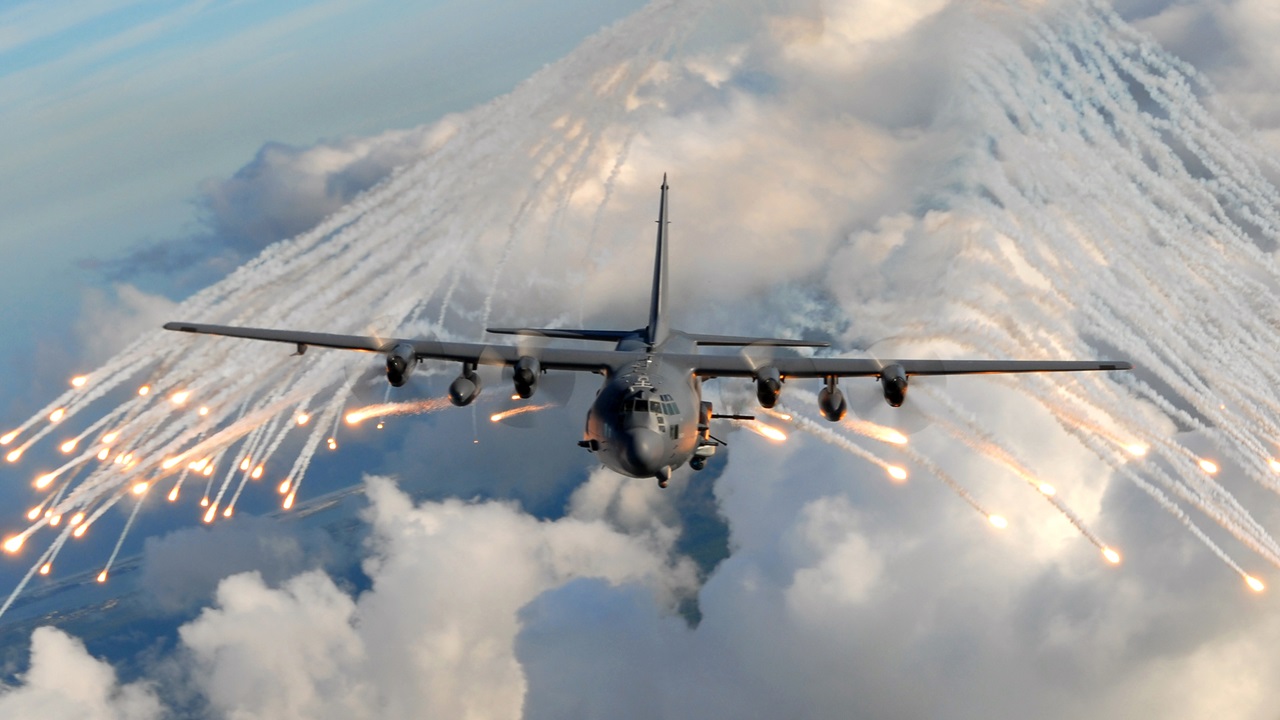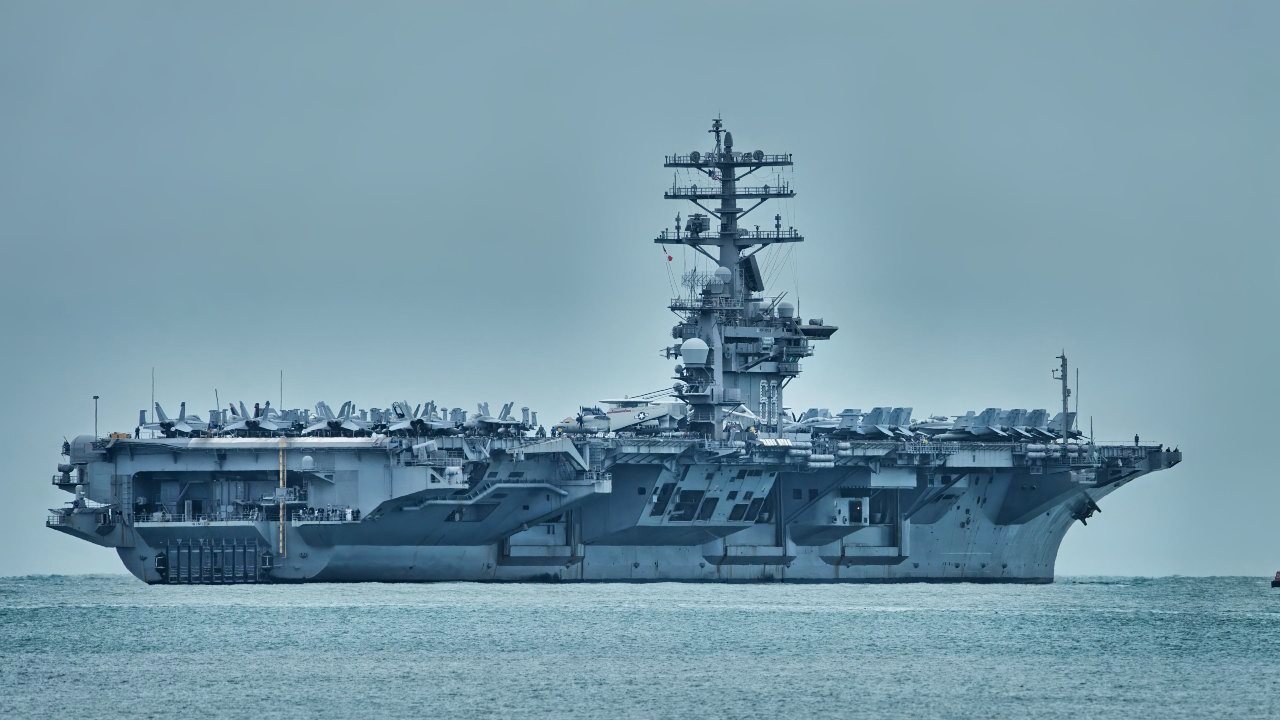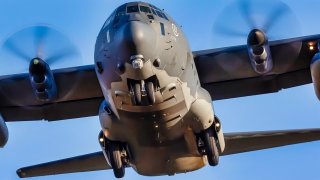To Fight China, Put the C-130 Back on Aircraft Carriers
Operating C-130s off of American aircraft carriers in the Pacific could provide a sufficient threat to throw China’s existing combat calculus off balance.
As a variety of new systems and platforms work their way toward service aimed specifically at deterring conflict with China, the United States needs a near-term deterrent with similar capability and capacity to maintain a strategic edge in the interim. One little-known C-130 program out of the 1960s, combined with a more modern effort out of the Air Force Research Lab, could provide exactly that.
This concept would require launching dozens of low-observable cruise missiles from palletized launchers deployed from the back of C-130 cargo planes that operate off of American aircraft carriers… and it’s not quite as crazy as it sounds.
This month, Air Force Secretary Frank Kendall will roll out a sweeping overhaul of the United States Air Force and Space Force aimed at undoing decades worth of technological – and even operational – atrophy caused by America’s transition away from Great Power Competition and toward asymmetrical conflicts in the Middle East. Kendall and the senior leaders from both branches will be reorganizing unit structures, deployment rotations, weapon and platform acquisitions, and even the training requirements for mission-capable Airmen with the singular purpose of repositioning the United States as a deterrent force so potent and ominous to its enemies that American airpower shouldn’t have to win a war at all: instead, its imposing presence alone will deter would-be adversaries.
But getting there will be a massive undertaking – and explaining why is sure to anger at least two different groups of frequent commenters.
ADDRESSING CHALLENGES MEANS ACKNOWLEDGING THEM
Those who see America’s defense expenditures as bloated and wasteful will surely cringe if I explain that, despite the dollar figure of the U.S. defense budget continuing to rise (thanks in large part to inflation), America spends less on defense today – as a percent of its Gross Domestic Product – than it did throughout much of the Cold War. In fact, if U.S. defense spending matched the percentage of America’s buying power today that it did at its height in the 1960s, the 2023 defense budget would have been over $2.5 trillion, rather than the comparably paltry $816 billion Uncle Sam’s gun clubs were allocated.

Deterrence in a geopolitical environment similar to what existed during the Cold War is expensive. So, if we want the outcome of the 21st-century arms race against China to mirror the peaceful conclusion of the one against the Soviet Union, we – as a people – will need to get over our collective sticker shock when programs are unveiled or, even worse, suffer setbacks or delays.
Those same commenters will argue that America’s defense budget is already bigger than the next 10 or even 20 countries combined… because they saw that fact in a meme somewhere. The truth is that the figures reflected in those memes are self-reported, and it shouldn’t surprise you to learn that countries with a systemic lack of transparency or oversight tend not to tell the truth about their military spending. Recent expert assessments place China’s actual military spending at north of $700 billion per year.
Further, those who exercise the brand of American exceptionalism that causes them to take deep, personal offense to the very idea that the United States may not be able to steamroll over any potential opponent will also be mad when I explain that this influx of spending will be required because today’s military is currently designed to win the last wars it fought, not the next the ones. Today, the United States military simply cannot match China fighter-for-fighter, missile-for-missile, or ship-for-ship in the Pacific theater. America’s sprawling military apparatus is vast, but in many ways, cannot be allocated in its entirety to any single conflict without leaving serious defense obligations unmet. And as we’ve seen in recent months in Ukraine, the Red Sea, and Gaza conflicts don’t wait until your resources are no longer spread thin to kick off.
This means the combat calculus in the Pacific is not the entirety of the U.S. military versus the entirety of China’s… but rather, the assets and forces America can send to that theater versus the entirety of the Chinese military.
CHINA DOES NOT NEED TO MATCH AMERICAN MILITARY MIGHT
These challenges are only worsened by China’s decade-spanning practice of closely observing American combat tactics in conflicts all around the world, and then developing weapon systems not aimed at matching the observed American capabilities, but rather at taking advantage of identified weaknesses. One of the fundamental truths of warfare is that it’s much cheaper to damage, destroy, or degrade military capabilities than it is to design, develop, and build them, and China has spent years looking over America’s suit of armor for weak points, and then devising strategies and weapon systems aimed directly at those gaps.
This is not only my assessment: There’s a growing chorus of Defense officials echoing this very sentiment within the Pentagon today. This is precisely why the Air Force is now looking down the barrel of its biggest overhaul in decades.

“Xi Jinping has told his military to be ready to invade Taiwan by 2027,” Frank Kendall said in a January interview. “China is a thinking, well-resourced adversary. They’re now thinking about the things we’ve said we’re going to do and how they’re going to defeat them. That’s why we have to re-optimize. We’re in a race. And we can’t just hope we win. We have to actually do things to make sure we stay ahead.”
There are dozens of efforts underway aiming to modernize America’s airpower apparatus after decades of technological stagnation and combat operations in permissive environments. A new stealth air superiority fighter, a new stealth bomber, and a variety of AI-enabled drones known as “collaborative combat aircraft” are all in active development and are projected to enter service in the 2030s. Yet, even the most optimistic timelines (and budget projections) don’t envision viable fleets of these platforms in service until perhaps midway through the coming decade. That leaves the United States with an unnerving 10-plus years between where the Air Force is and where its planners believe it needs to be.
Again, it’s important to understand the difference between identifying shortcomings that need to be addressed and dismissing the combat capacity or prowess of America’s warfighters. If a war were to break out today, American servicemembers would do what they always have: fight, adapt, and find a way to win. But winning such a bloody conflict would not feel much like a victory at all. War games conducted by the Center for Strategic and International Studies, for instance, show American victory is all but assured following a Chinese invasion of Taiwan… but even the best outcomes still came at the expense of at least one but sometimes two multi-billion dollar aircraft carriers, thousands of servicemembers’ lives, and countless aircraft lost on the runway to long-range missiles.
Even an easily won war is a blood-soaked travesty we should tolerate only out of necessity. The best outcome then is to deter such a war from breaking out at all. In a perfect world, we could do that with diplomacy alone… but diplomacy is often only effective when casting a broad, looming military shadow.
THE US NEEDS AIRPOWER EN MASS
In a recent series of war games conducted by the Mitchell Institute to assess the potential strategic and tactical uses of collaborative combat aircraft, also called CCA or AI-enabled drones, all three “Blue Force” (or American-aligned) teams aimed to use a mass of low-to-medium cost CCA drones to blunt the sharpest edges of China’s anti-access/area denial strategy – which some senior Defense officials are characterizing as the most advanced and integrated air defense apparatus on the planet.
The concepts and methodologies these teams employed all called for using these drones in a variety of functions and to launch them in a variety of ways, including runway-less rocket-propelled launches and deployments from heavy payload bombers. This concept is meant to offset China’s strategy which is to use long-range cruise and ballistic missiles to wipe out local airstrips and keep American aircraft carriers at bay, forcing American aircraft to operate from further removed bases, increasing the distances they have to cover and reducing sortie rates sufficiently to make air defense a simpler exercise.
This airpower en mass strategy seems entirely sound, but it’s predicated on the idea of a conflict in 2030 and on defense budgets between now and then that will allow for the rapid acquisition of fleets of advanced AI-enabled drones and 6th generation fighters required to relay commands in the fight (along with some other newly-fielded autonomous systems to boot).
So, what does this mean for such a conflict if the United States doesn’t manage to field all that by 2030?
If China has carefully watched the way the American military conducts combat operations and has developed weapons, systems, and tactics aimed precisely at mitigating those standard practices, deterring conflict with China will have to mean demonstrating the American military’s ability to rapidly adapt today, using the weapons and platforms already available and relying on already proven technology, but in surprising and effective new ways.


